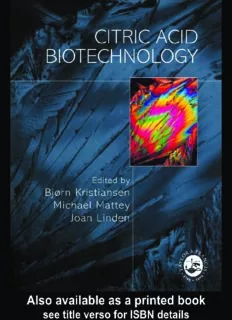
Citric Acid Biotechnology PDF
Preview Citric Acid Biotechnology
Citric Acid Biotechnology Citric Acid Biotechnology BJØRN KRISTIANSEN Borregaard Industries Ltd, Norway MICHAEL MATTEY Department of Bioscience and Biotechnology, University of Strathclyde, UK JOAN LINDEN Gluppevelen 15, 1614 Fredikstad, Norway UK Taylor & Francis Ltd, 1 Gunpowder Square, London EC4A 3DF USA Taylor & Francis Inc., 325 Chestnut Street, 8th Floor, Philadelphia, PA 19106 This edition published in the Taylor & Francis e-Library, 2002. Copyright © Taylor & Francis 1999 All rights reserved. No part of this publication may be reproduced, stored in a retrieval system, or transmitted in any form or by any means, electronic, electrostatic, magnetic tape, mechanical, photocopying, recording or otherwise, without the prior permission of the copyright owner. British Library Cataloguing in Publication Data A catalogue record for this book is available from the British Library. ISBN 0-7484-0514-3 (cased) Library of Congress Cataloguing-in-Publication Data are available Cover design by Jim Wilkie ISBN 0-203-48339-1 Master e-book ISBN ISBN 0-203-79163-0 (Glassbook Format) Contents 1 A Brief Introduction to Citric Acid Biotechnology page 1 1.1 Citric acid from lemons 1 1.2 Synthetic citric acid 2 1.3 Microbial citric acid 2 1.4 Citric acid by the surface method 3 1.5 The submerged process for production of citric acid 4 1.6 Continuous and immobilized processes 5 1.7 Yeast based processes 6 1.8 The koji process 7 1.9 Uses of citric acid 7 1.10 Effluent disposal 8 1.11 Conclusions 8 1.12 References 9 2 Biochemistry of Citric Acid Accumulation by Aspergillus niger 11 2.1 Introduction 11 2.2 Glucose catabolism in A. niger and its regulation 12 2.3 Regulation of citric acid biosynthesis 19 2.4 Role of citrate breakdown in citrate accumulation 21 2.5 Export of citric acid from A. niger 24 2.6 References 25 3 Biochemistry of Citric Acid Production by Yeasts 33 3.1 Introduction 33 3.2 Synthesis of citric acid from n-alkanes 35 3.3 Synthesis of citric acid from glucose 46 3.4 Conclusions 50 3.5 References 50 4 Strain Improvement 55 4.1 Introduction 55 4.2 General aspects of strain improvement 55 v vi Contents 4.3 Isolation of recombinant strains using the parasexual cycle in A. niger 60 4.4 Genetic engineering 61 4.5 Concluding remarks 64 4.6 Acknowledgements 65 4.7 References 65 5 Fungal Morphology 69 5.1 Introduction 69 5.2 Factors affecting Aspergillus niger morphology in submerged culture 69 5.3 Effect of agitation 70 5.4 Effect of nutritional factors 74 5.5 Effect of inoculum 82 5.6 Conclusions and perspectives 82 5.7 References 82 6 Redox Potential in Submerged Citric Acid Fermentation 85 Nomenclature 85 6.1 Introduction 85 6.2 Overview 86 6.3 Theory 87 6.4 Measurement of redox potential 88 6.5 Significance of redox potential 89 6.6 Redox potential in citric acid fermentation 91 6.7 Regulation of the redox potential 95 6.8 Regulation of redox potential in citric acid fermentation 95 6.9 Scale-up based on redox potential 101 6.10 Conclusions 102 6.11 References 103 7 Modelling the Fermentation Process 105 7.1 Introduction 105 7.2 Aspergillus based models 107 7.3 Yeast based models 113 7.4 Conclusion 119 7.5 References 119 8 Mass and Energy Balance 121 Nomenclature 121 8.1 Introduction 122 8.2 Metabolic description of A. niger growth 123 8.3 Mass and energy balances 125 8.4 Kinetics of growth and citric acid production by A. niger 128 8.5 Carbon and available electron balances 130 8.6 Conclusion 131 8.7 References 132 9 Downstream Processing in Citric Acid Production 135 9.1 Pretreatment of fermentation broth 135 9.2 Precipitation 136 Contents vii 9.3 Solvent extraction 139 9.4 Adsorption, absorption and ion exchange 142 9.5 Liquid membranes 143 9.6 Electrodialysis 144 9.7 Ultrafiltration 145 9.8 Immobilization of micro-organisms 146 9.9 References 146 10 Fermentation Substrates 149 10.1 Introduction 149 10.2 Molasses 150 10.3 Refined or raw sucrose 156 10.4 Syrups 156 10.5 Starch 157 10.6 Hydrol 157 10.7 Alkanes 157 10.8 Oils and fats 158 10.9 Cellulose 158 10.10 Other medium redients 158 10.11 Conclusion 159 10.12 References 159 11 Design of an Industrial Plant 161 Nomenclature 161 11.1 Design of an industrial plant 163 11.2 Data required 163 11.3 Design basis 165 11.4 Scope definition 167 11.5 Process package 167 11.6 Raw material 169 11.7 Substrate preparation 169 11.8 Fermentation 170 11.9 Design of a stirred tank reactor 171 11.10 Airlift and bubble column reactors 174 11.11 Product isolation 176 11.12 Cell removal 177 11.13 Purification 178 11.14 Crystallization stages 182 11.15 Product packaging 183 11.16 Effluent and by-products 183 11.17 In conclusion 183 11.18 References 184 Index 187 Contributors Ho Ai Meng Amy Blk 135 Pasir Ris Street 11, # 06-239, Singapore 510135 Marin Berovic Department of Chemistry and Biochemical Engineering, National Chemistry Laboratory for Biotechnology and Industrial Mycology, 1115 Slo, Ljubljana, Hajdrihova 19 POB 30, Slovenia Pawel Gluszca Department of Bioprocess Engineering, Technical University of Lodz, Wolczanska 175 90-924 Lodz, Poland Bjørn Kristiansen Borregaard Industries Ltd, PO Box 162, 1701 Sarpsborg, Norway Liliana Krzystek Department of Bioprocess Engineering, Technical University of Lodz, Wolczanska 175 90-924 Lodz, Poland Christian Kubicek Institute for Biochemical Technology and Microbiology, University of Technology Getreidemarkt 9/1725, A-1060 Wien, Austria
Description: